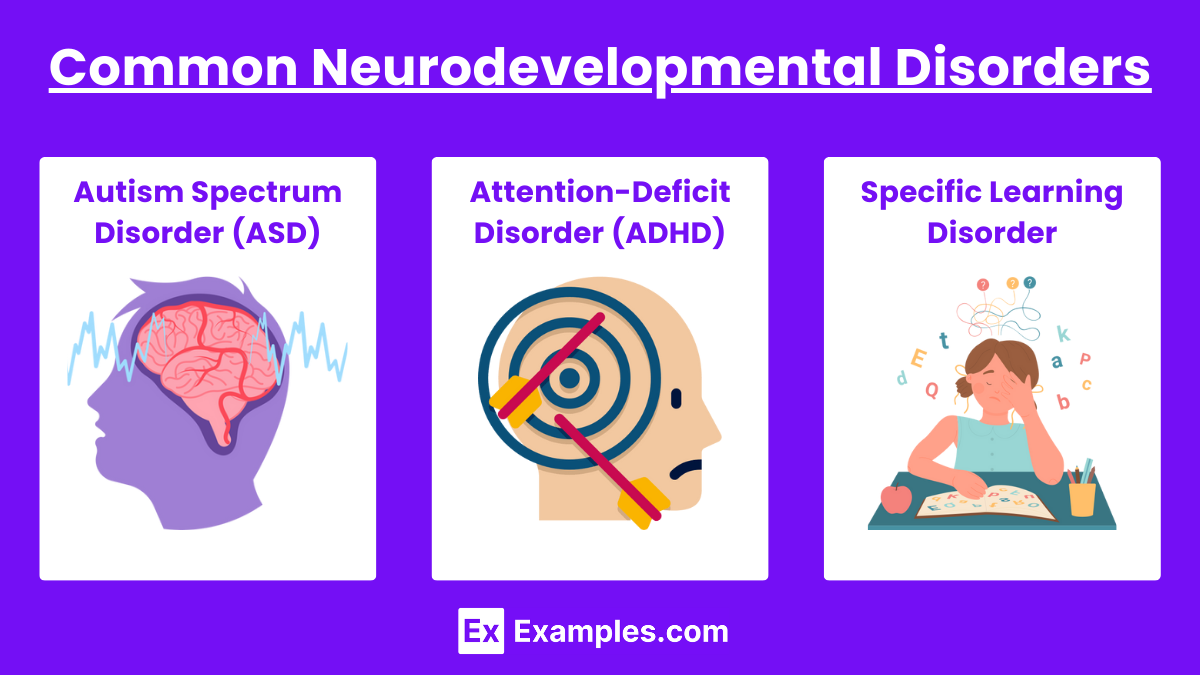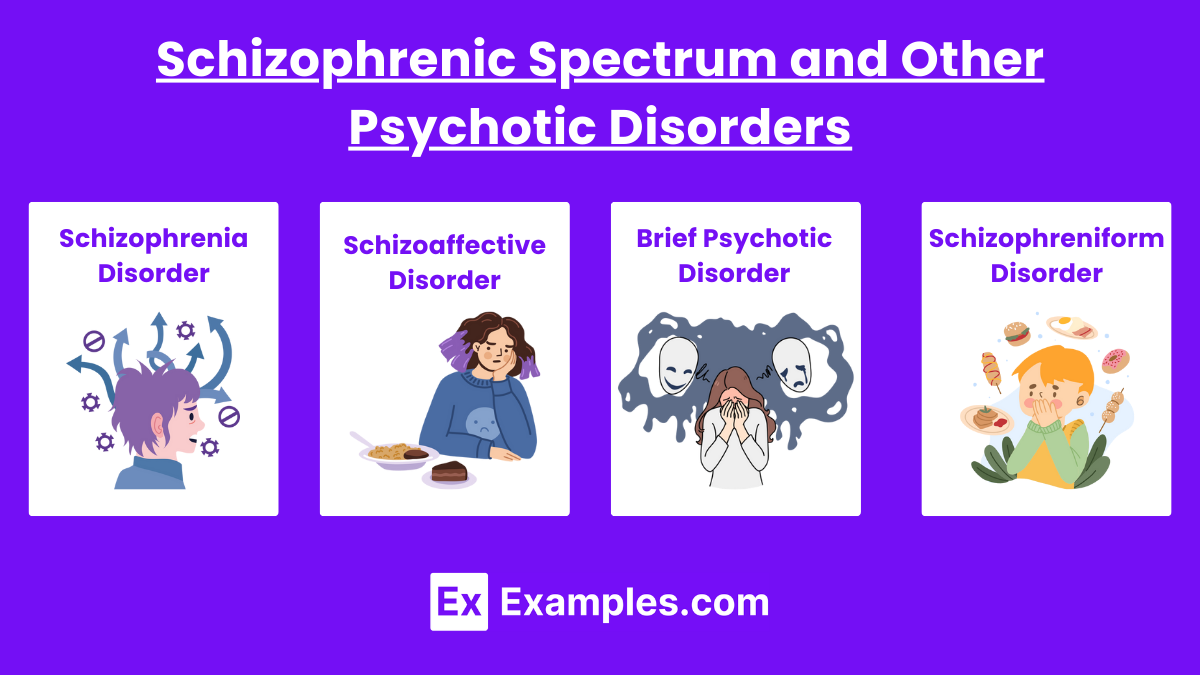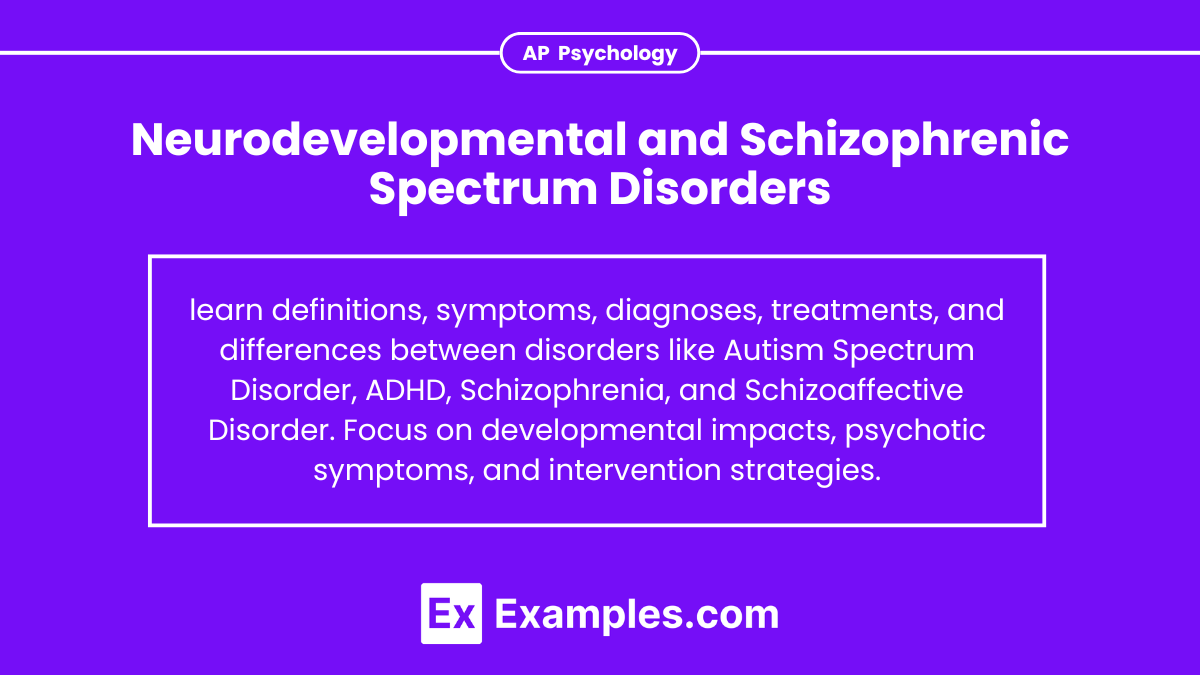Neurodevelopmental and schizophrenic spectrum disorders encompass a range of conditions that impact mental health and development. Neurodevelopmental disorders, such as Autism Spectrum Disorder and ADHD, manifest early in childhood and affect cognitive, social, and academic functioning. Schizophrenic spectrum disorders, including Schizophrenia and Schizoaffective Disorder, typically emerge in adolescence or early adulthood, characterized by psychotic symptoms. Understanding these disorders is crucial for the AP Psychology exam, as it involves exploring their symptoms, Nursing Diagnosis, and treatments comprehensively.
Learning Objectives
Understand the definitions, symptoms, diagnosis, and treatment options of neurodevelopmental disorders (such as Autism Spectrum Disorder, ADHD, and Specific Learning Disorder) and schizophrenic spectrum disorders (including Schizophrenia, Schizoaffective Disorder, Brief Psychotic Disorder, and Schizophreniform Disorder). Focus on comparing and contrasting these disorders, recognizing the onset and course of each, and comprehending the biological, psychological, and Social Issues involved in their development and management.
Neurodevelopmental Disorders

Neurodevelopmental disorders are a group of conditions with onset in the developmental period. They manifest early in development, often before the child enters grade school, and are characterized by developmental deficits that produce impairments of personal, social, academic, or occupational functioning. The range of developmental deficits varies from very specific limitations of learning or control of executive functions to global impairments of social skills or intelligence.
Common Neurodevelopmental Disorders

Autism Spectrum Disorder (ASD)
- Definition: A complex developmental condition involving persistent challenges with social communication, restricted interests, and repetitive behaviors.
- Symptoms:
- Difficulty with communication and interaction with other people
- Restricted interests and repetitive behaviors
- Symptoms that hurt the person’s ability to function properly in school, work, and other areas of life
- Diagnosis: Based on behavior and development; symptoms typically recognized in the first two years of life.
- Treatment: Behavioral therapy, speech therapy, occupational therapy, and sometimes medications.
Attention-Deficit Disorder (ADD)
- Definition: A chronic condition including attention difficulty, hyperactivity, and impulsiveness.
- Symptoms:
- Inattention (e.g., difficulty sustaining attention in tasks or play activities)
- Hyperactivity (e.g., fidgeting, tapping hands or feet, or talking excessively)
- Impulsivity (e.g., interrupting or intruding on others)
- Diagnosis: Often diagnosed in childhood but can continue into adulthood.
- Treatment: Medications (stimulants and non-stimulants), behavioral therapy, and counseling.
Specific Learning Disorder
- Definition: A type of neurodevelopmental disorder that impedes the ability to learn or use specific academic skills (e.g., reading, writing, or arithmetic), which are the foundation for other academic learning.
- Symptoms:
- Difficulty reading (dyslexia)
- Difficulty with writing (dysgraphia)
- Difficulty with math (dyscalculia)
- Diagnosis: Identified when the individual’s achievement in reading, mathematics, or written expression is substantially below what is expected for their age, schooling, and level of intelligence.
- Treatment: Educational interventions, special teaching methods, and use of accommodations.
Schizophrenic Spectrum and Other Psychotic Disorders

Schizophrenic spectrum and other psychotic disorders are characterized by abnormalities in one or more of the following five domains: delusions, hallucinations, disorganized thinking (speech), grossly disorganized or abnormal motor behavior (including catatonia), and negative symptoms.
Schizophrenia
- Definition: A chronic brain disorder that affects less than one percent of the U.S. population.
- Symptoms:
- Positive Symptoms: Delusions, hallucinations, and disorganized thinking
- Negative Symptoms: Diminished emotional expression, lack of motivation, and social withdrawal
- Cognitive Symptoms: Poor executive functioning, trouble on Focus Statement or paying attention, and Problem Solving with working memory
- Diagnosis: Symptoms must persist for at least six months, including at least one month of active-phase symptoms.
- Treatment: Antipsychotic medications, psychosocial treatments, and coordinated specialty care (CSC).
Schizoaffective Disorder
- Definition: A mental health condition including schizophrenia symptoms, such as hallucinations or delusions, and mood disorder symptoms, such as depression or mania.
- Symptoms:
- Symptoms of schizophrenia (delusions, hallucinations)
- Symptoms of mood disorders (depression, mania)
- Diagnosis: Periods of illness during which there is a major mood episode concurrent with criteria for schizophrenia.
- Treatment: Combination of Medication List (antipsychotics, antidepressants, mood stabilizers) and psychotherapy.
Brief Psychotic Disorder
- Definition: A sudden, short-term display of psychotic behavior, such as hallucinations or delusions, which occurs with a sudden onset and lasts for less than one month, with eventual return to full baseline functioning.
- Symptoms:
- Delusions
- Hallucinations
- Disorganized speech
- Grossly disorganized or catatonic behavior
- Diagnosis: Symptoms must last at least one day but less than one month, with an eventual full return to pre-illness level of functioning.
- Treatment: Antipsychotic medications and supportive psychotherapy.
Schizophreniform Disorder
- Definition: A disorder with symptoms of schizophrenia that are present for a significant portion of the time within a one-month period, but signs of disruption are not present for the full six months required for the diagnosis of schizophrenia.
- Symptoms: Same as schizophrenia but for a duration of one to six months.
- Diagnosis: Symptoms must last more than one month but less than six months.
- Treatment: Antipsychotic medications and psychosocial interventions.


